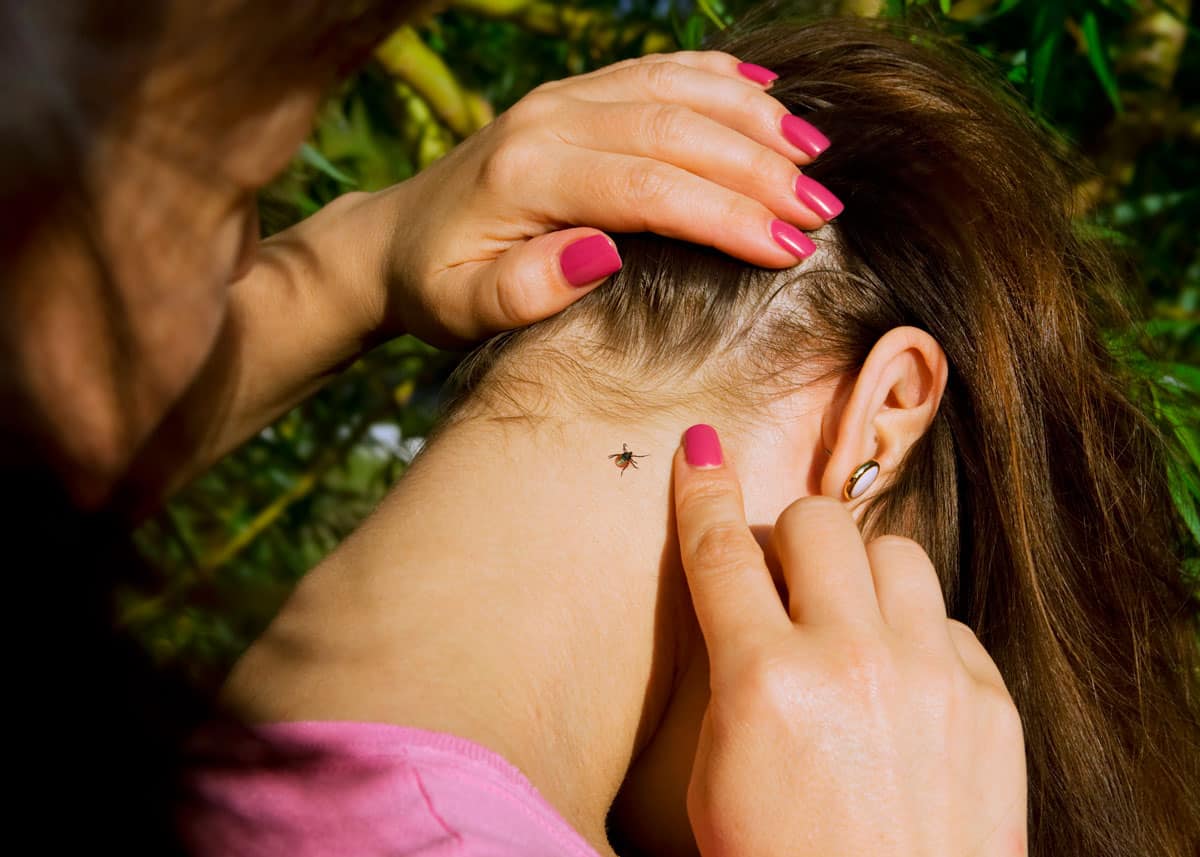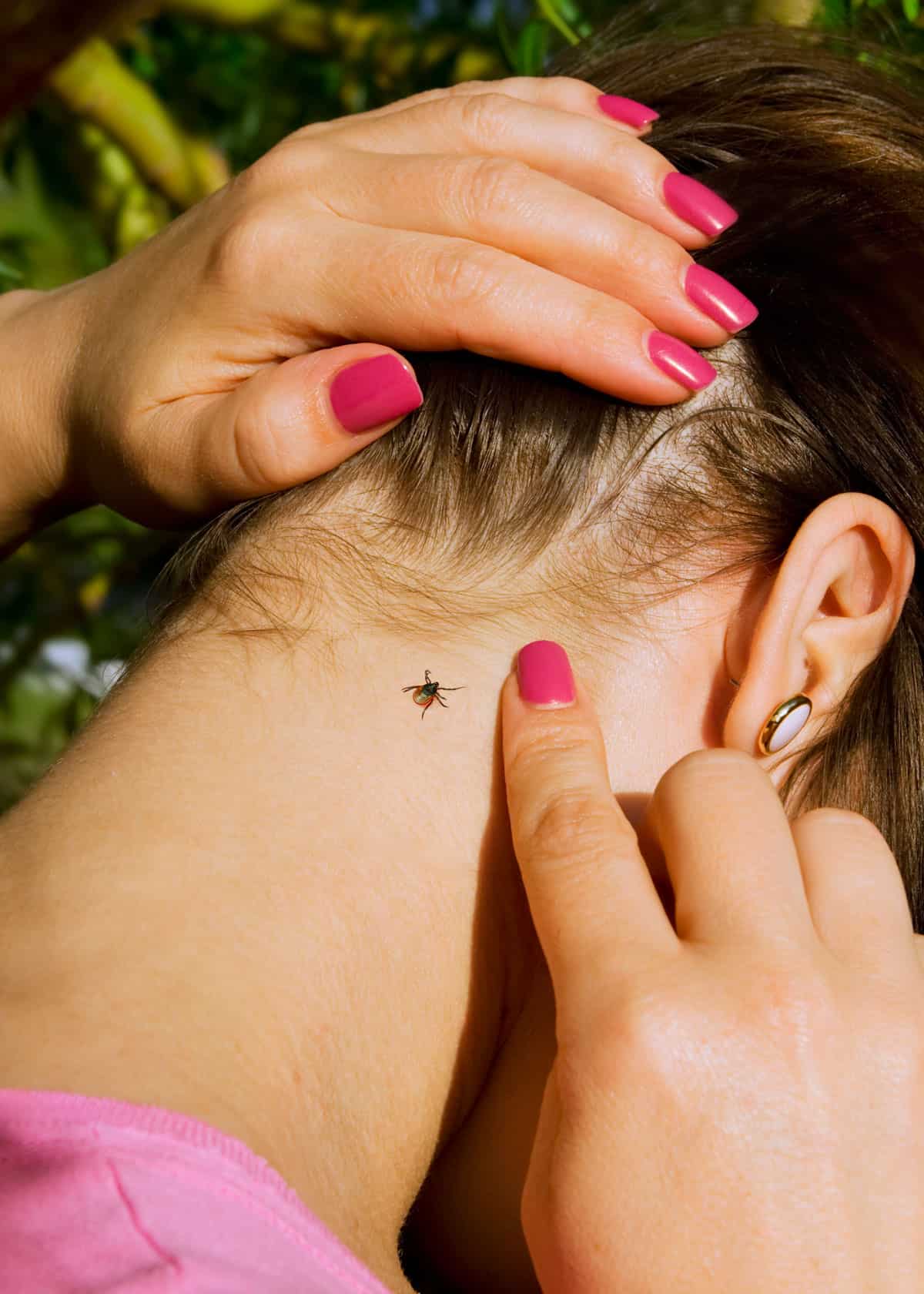5 Best Tick Repellents for Humans (Natural, Clothing, Chemical, Yard)
In this post, you’ll learn the best tick repellent for humans. We cover 5 options – so you can choose the one that fits you best. If you enjoy being outside, you need to know how to keep the ticks away.
Not only are they disgusting – they can make you very sick.

Best Tick Repellent for Humans: 5 Great Options
All-natural sprays, essential oils, yard treatments, clothing, and chemicals are all good tick deterrents.
At home, in your yard, out on the hiking trails, camping or spending the summer in a cabin by a lake… if you are outdoors then the chances of encountering ticks is there.
Here, we will discuss each tick-repelling option for you to make an informed decision about which is best for you and your family.
1. Clothing Tick Repellent
Because ticks spend a lot of time on the ground, or near it, there are precautions you can take when out wandering the wilds.
One great option is wearing long pants. There are lightweight, breathable hiking pants for men and women designed to make your hike comfortable. These, along with good ankle high hiking boots provide a layer of defense against ticks.
So, if you are wearing long pants, then they can’t get to your skin and if you have treated those long pants with a tick repellent they will drop off straight away and you both go about your lives.
There are three ways you can have tick-repellent clothes:
- Spray your pants with the same spray you have taken along for mosquitoes, as most chemical sprays will affect and deter ticks as well as a host of other creepy crawlies, not just mosquitoes
Apply a specialized clothing insect repellent like Permethrin that is effective against ticks, mosquitoes, mites and other creepy crawlies you don’t want up your pants leg. These sprays usually last quite a while and don’t harm or degrade your clothes in any way. They are also odorless so it doesn’t taint that fresh air you are enjoying. Sawyer Products has one that lasts 6 weeks and or 6 washes.
Buy clothes with specially designed built-in tick repellent. A lot of avid campers and outdoors people have anti-tick socks as part of their gear. Seeing as ticks are found low to ground it’s a good idea to pay special attention to the part of you at tick height, like your socks just in case they crawl up your boots when you stop for a rest. Realtree makes moisture-wicking socks with built-in insect repellent specially designed to repel ticks.
There are also bracelets for the kids making tick and mosquito repellent more fun on their next camping adventure, which they could wear as an anklet to further enhance the chances of repelling ticks.
2. All-Natural Tick Repellents
Natural, environmentally friendly and non-harmful insect repellent alternatives are gaining popularity by the day with more and more people steering away from toxic chemical brands and opting for a more natural substitute.
After researching the toxins our bodies absorb easily through the skin, many people do not hesitate to change to something more natural, especially with the treatments they used on children, pets and babies.
Toddlers and babies alongside many adults with skin conditions have very sensitive skin which means natural products are generally their best option.
So, here we will discuss the different types of natural repellents alongside a special section for toddlers and babies in the essential oils section.
Natural Sprays: All natural sprays using essential oils, botanical extracts and essences are easily made yourself or purchased.
Usually with a big DEET FREE stamped across it, the natural insect repellents are not only popular but happy to advertise they are 100% natural, environmentally friendly, great for sensitive skin, cruelty free (no animal testing) and non-harmful to most skin types. Great news for all of those with sensitive skin.
Nature has some absolute powerhouses of insect repellent in the form of citrus-like lemon, lemongrass, citronella, alongside eucalyptus, lavender and cedar which are great for repelling ticks along with mosquitoes and other biting insects.
Repel has combined two of these powerhouses with lemon and eucalyptus to provide you with a natural spray that ticks, mosquitoes and biting flies hate. Plus, it smells great!
Check current price for Repel on Amazon.
Bug Mace is another great option for the entire family. Using a blend of high-quality essential oils, it’s safe for adults and kids, to spray on their clothes – even good old Fido as well.
Organic, Deet Free and offering seven hours of protection, it’s fresh lemon vanilla scent is a delight. Check current price for Bug Mace
Many natural sprays can be used for people as well as our four-legged friends. 100% natural, plant-based and specially designed against ticks this can be applied to dogs before a day’s hike as well.
3. Essential Oil Tick Repellent
Essential oils are the botanical powerhouse of the plant world. Of course, some are more potent than others like basically everything in the citrus family, cedar, eucalyptus and lavender just to name a few.
The good thing is – adding these essential oils to a safe base oil like almond oil means you can make your own tick and insect repellent at home and the best part is, you can make it with the fragrances you prefer. A lovely lemongrass and rosemary perhaps or a lavender and geranium.
More reading: Campers Guide to Essential Oil Bug Repellent
Luckily there are pre-made oils available especially crafted and blended to deter ticks and biting insects. Or you can buy the oil already blended and dilute it yourself rather than buy bottles of every type of oil.
Plant Guru’s Shoo Fly has taken all the fuss out of making your own tick repellent. This versatile oil blend can be used in a diffuser or oil burner at home, added into candles, blended in a base oil like almond oil to make your own repellent or applied to your clothes to deter ticks.
Which means that one bottle is enough to protect your home, family and is even gentle enough when blended for babies and toddlers.
4. Yard Treatments for Tick Repellent
All natural yard treatments that kill the adult, larvae and the eggs of ticks while not harming other beneficial insects like bees are a great way to go.
Not only do they protect your backyard from those nasties you don’t want to come in, they enable the beneficial insects free access to pollinate your rose garden and veggie patch so the kids can enjoy their time outside while you are gardening. It’s a win win.
Not just for the yard, because they are natural they can be used for the areas close to your home like patios and garden beds. Cedar Oil is a terrific tick deterrent safe for kids and pets.
Wondercide all natural tick repellent eco-friendly and 100% biodegradable compounds are perfect for deterring all manner of other harmful insects as well like spiders, scorpions and it even deters snakes making your yard a lot safer for the kids to play.
As a chemical option, Permethrin is the only insecticide recommended by the EPA (Environmental Protection Agency) to treat clothes, camping equipment and to protect your backyard from ticks, mosquitoes and other biting insects.
In fact, the US Military uses it to protect their soldiers by treating their uniforms with it as it bonds readily with fabric.
It is pet safe once it has dried so is safe to use as a spray in your backyard to prevent all manner of creepy crawlies and ticks from invading your yard.
As with all chemical sprays, please be sure to read the instructions carefully and lock your fur babies away before application to ensure your loved ones are safe during and after the application process.
Insecticide treatments high in Permethrin (36.8%) are very effective against all manner of creepy crawlies and biting insects like Tengard.

5. Chemical Tick Repellent
Many people are concerned about using harsh chemicals near their family and especially children. There are some that have less impact on the environment, break down readily and are seemingly harmless after a while but the problem is that when you apply them to your skin it is absorbed into your body.
But for hard core outdoors person, hunters and people spending days if not weeks in the great outdoors sometimes they need that little extra protection.
The two main insect and tick repellent chemicals you will find are Deet and Picaridin. These active ingredients are the ones that ticks hate.
Deet and Picaridin: The main thing to remember is that the percentage doesn’t equal how effective it is. Instead, the higher the percentage equals the length of time it will last.
So, say you have a bug spray that is 20% it just means it may only last 6 hours, compared to a 98% which may last 2 days. All labels will show you the strength of the active ingredient so you can choose for yourself.
Here are 7 tips to avoid ticks while hiking.

Tick Removal
If you return from camping or hiking and find a tick, they are very easy to remove.
Just grab a set of pointed tweezers, grip the tick right down where it has borrowed in and gently pull applying a steady pressure. This will remove the tick and you can dispose of it… or place it in a plastic bag to take to the doctors for identification if you are worried.
Remember: Always put the tweezers as close to the point of entry as possible. If not, you risk squeezing the entire contents of the tick back into your body. As far as tick interactions go, regurgitation of the stomach is a worst case scenario. If you can’t do this safely, go see a doctor right away.
Try to always use tweezers because if you just pull the tick out with your fingers you don’t get down far enough to grab their heads and you can leave the head borrowed in.
If this happens, try to remove the head with tweezers but if you can’t then disinfect the site and the head should make its way out on its own.
There are some specially made tick removal tools – they aren’t expensive and work better than a standard set of tweezers. This one by TickCheck comes with 2 specialty tools and a little pouch.

Can you squish a tick? Get the answer, plus 16 more gross tick facts

Deet vs Picaridin
More and more people are steering away from Deet after Picaridin was proven to be just as effective without as many harmful effects on your skin, body and internal organs after long term use.
Picardin’s popularity has grown vastly in the US and is the main ingredient preferred in Europe. Both are chemicals that should not be applied to or near aggravated skin, abrasions, wounds or your face.
Sawyer Products have a 20% Picaridin insect repellent effective for 12 hours which you can use to spray your clothes and yourself as protection against parasitic insects like mosquitoes, ticks and biting flies.
For the most hard core insect repellent out there Sawyer Products has a 98% Deet formula made for those spending time in areas heavily infested with ticks and mosquitoes.
Websites like My Repellent Finder created by Oregon State University are also a good resource to have a quick look at. Having done all the research for you, they list a range of options mentioned above, not just your traditional bug spray.

Your Turn
How will you avoid the plague of ticks? What methods do you plan on using? Have a tip to share? Let me know in the comments!













